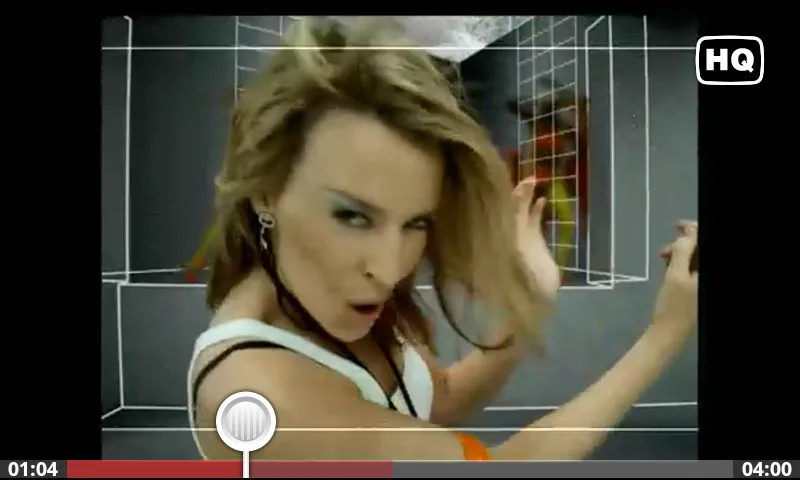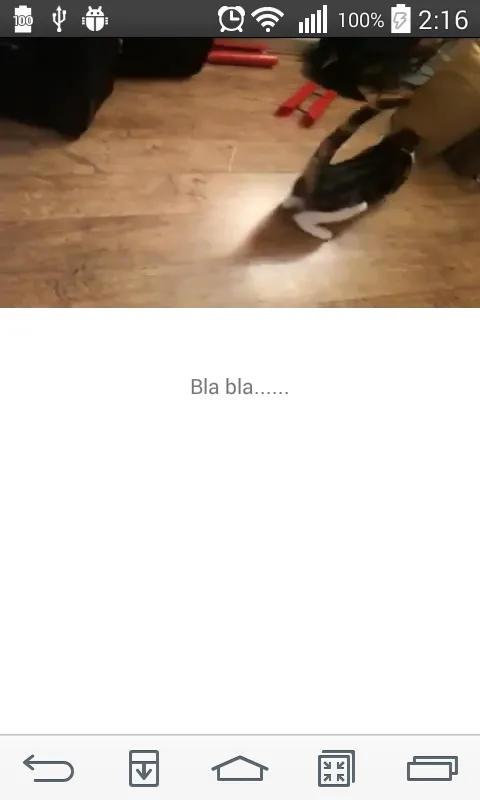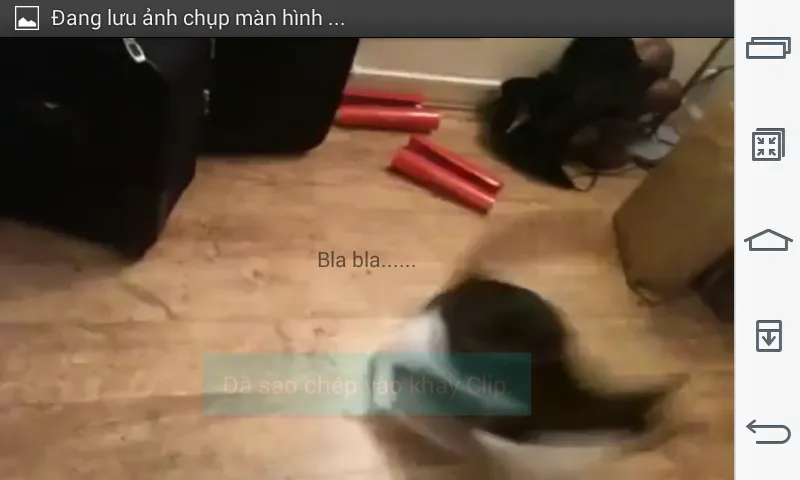我正在尝试复制 Android 市场上最新的 YouTube 应用程序的功能。在观看视频时,有两个单独的布局,一个是纵向布局,提供额外的信息,另一个是横向布局,提供视频的全屏视图。

YouTube 应用程序纵向布局

YouTube 应用程序横向布局
(很抱歉照片的随机性,但它们是我能找到的实际布局的第一批图片)
通常情况下,这很容易做到-只需在layout-land中指定一个备用布局即可。YouTube应用程序做得非常好的事情(也是我要复制的内容)是,在方向改变时,视频会继续播放,不必从开头重新缓冲。
我已经想出了覆盖onConfigurationChange()并设置新的LayoutParameters将允许我调整视频大小而不强制重新缓冲 - 但是当旋转屏幕多次时,视频会随机缩放到不同的宽度/高度。我尝试了所有类型的invalidate()调用VideoView,尝试在父RelativeLayout容器上调用RequestLayout()并尝试尽可能多的不同事物,但似乎无法使其正常工作。任何建议都将不胜感激!
这是我的代码:
@Override
public void onConfigurationChanged(Configuration newConfig) {
super.onConfigurationChanged(newConfig);
if (newConfig.orientation == Configuration.ORIENTATION_LANDSCAPE) {
questionText.setVisibility(View.GONE);
respond.setVisibility(View.GONE);
questionVideo.setLayoutParams(new RelativeLayout.LayoutParams(LayoutParams.FILL_PARENT, LayoutParams.FILL_PARENT));
} else {
questionText.setVisibility(View.VISIBLE);
respond.setVisibility(View.VISIBLE);
Resources r = getResources();
int height = (int) TypedValue.applyDimension(TypedValue.COMPLEX_UNIT_DIP, 150.0f, r.getDisplayMetrics());
questionVideo.setLayoutParams(new RelativeLayout.LayoutParams(LayoutParams.FILL_PARENT, height));
}
}
编辑:我在logcat中发现了一些有趣的输出,当我的视频旋转时会出现这些输出,似乎这是罪魁祸首 - 尽管我不知道如何修复它:
当正确调整大小(占据整个窗口)时的logcat输出
注意h=726
12-13 15:37:35.468 1262 1270 I ActivityManager: Config changed: { scale=1.0 imsi=310/4 loc=en_US touch=3 keys=1/1/2 nav=1/1 orien=2 layout=34 uiMode=17 seq=210}
12-13 15:37:35.561 1262 1268 I TIOverlay: Position/X0/Y76/W480/H225
12-13 15:37:35.561 1262 1268 I TIOverlay: Adjusted Position/X1/Y0/W403/H225
12-13 15:37:35.561 1262 1268 I TIOverlay: Rotation/90
12-13 15:37:35.561 1262 1268 I Overlay : v4l2_overlay_set_position:: w=480 h=224
12-13 15:37:35.561 1262 1268 I Overlay : v4l2_overlay_set_position:: w=402 h=726
12-13 15:37:35.561 1262 1268 I Overlay : dumping driver state:
12-13 15:37:35.561 1262 1268 I Overlay : output pixfmt:
12-13 15:37:35.561 1262 1268 I Overlay : w: 432
12-13 15:37:35.561 1262 1268 I Overlay : h: 240
12-13 15:37:35.561 1262 1268 I Overlay : color: 7
12-13 15:37:35.561 1262 1268 I Overlay : UYVY
12-13 15:37:35.561 1262 1268 I Overlay : v4l2_overlay window:
12-13 15:37:35.561 1262 1268 I Overlay : window l: 1
12-13 15:37:35.561 1262 1268 I Overlay : window t: 0
12-13 15:37:35.561 1262 1268 I Overlay : window w: 402
12-13 15:37:35.561 1262 1268 I Overlay : window h: 726
当不正确地调整大小时的Logcat输出(占据全屏幕的一小部分)
注意h = 480
12-13 15:43:00.085 1262 1270 I ActivityManager: Config changed: { scale=1.0 imsi=310/4 loc=en_US touch=3 keys=1/1/2 nav=1/1 orien=2 layout=34 uiMode=17 seq=216}
12-13 15:43:00.171 1262 1268 I TIOverlay: Position/X0/Y76/W480/H225
12-13 15:43:00.171 1262 1268 I TIOverlay: Adjusted Position/X138/Y0/W266/H225
12-13 15:43:00.171 1262 1268 I TIOverlay: Rotation/90
12-13 15:43:00.179 1262 1268 I Overlay : v4l2_overlay_set_position:: w=480 h=224
12-13 15:43:00.179 1262 1268 I Overlay : v4l2_overlay_set_position:: w=266 h=480
12-13 15:43:00.179 1262 1268 I Overlay : dumping driver state:
12-13 15:43:00.179 1262 1268 I Overlay : output pixfmt:
12-13 15:43:00.179 1262 1268 I Overlay : w: 432
12-13 15:43:00.179 1262 1268 I Overlay : h: 240
12-13 15:43:00.179 1262 1268 I Overlay : color: 7
12-13 15:43:00.179 1262 1268 I Overlay : UYVY
12-13 15:43:00.179 1262 1268 I Overlay : v4l2_overlay window:
12-13 15:43:00.179 1262 1268 I Overlay : window l: 138
12-13 15:43:00.179 1262 1268 I Overlay : window t: 0
12-13 15:43:00.179 1262 1268 I Overlay : window w: 266
12-13 15:43:00.179 1262 1268 I Overlay : window h: 480
也许有人知道'Overlay'是什么,为什么它没有得到正确的高度值?

